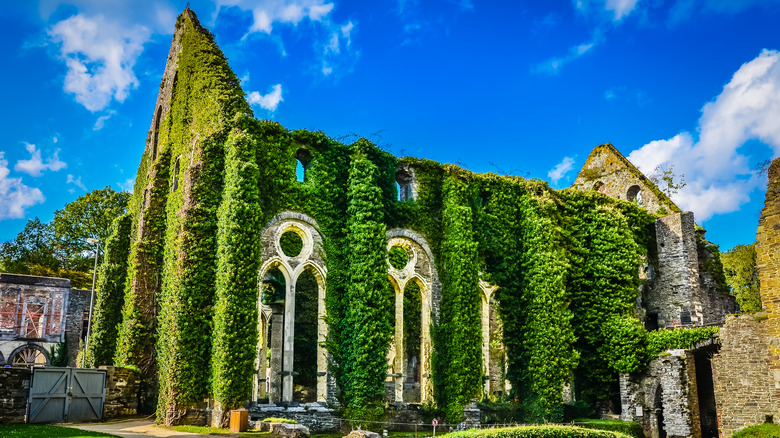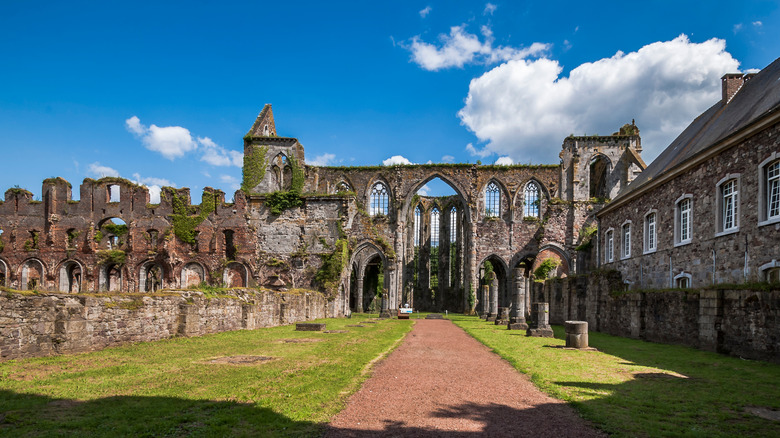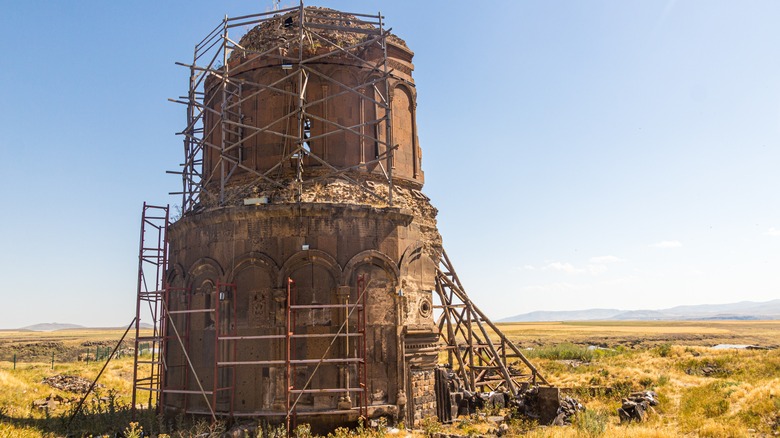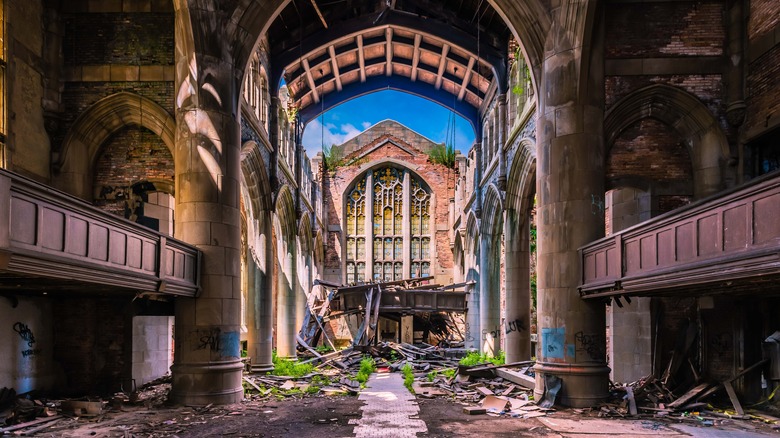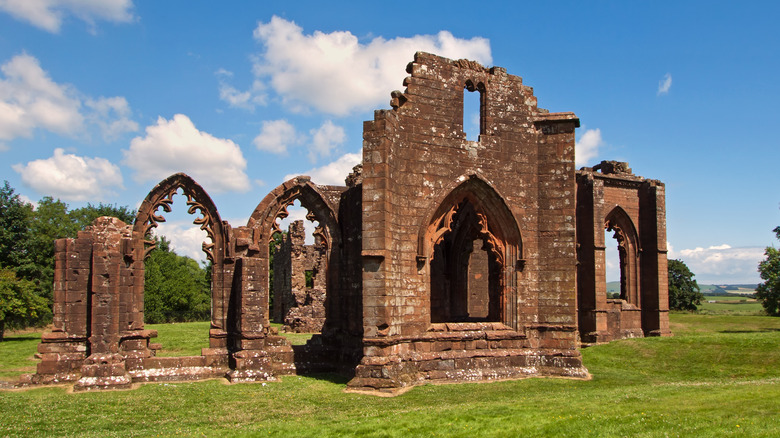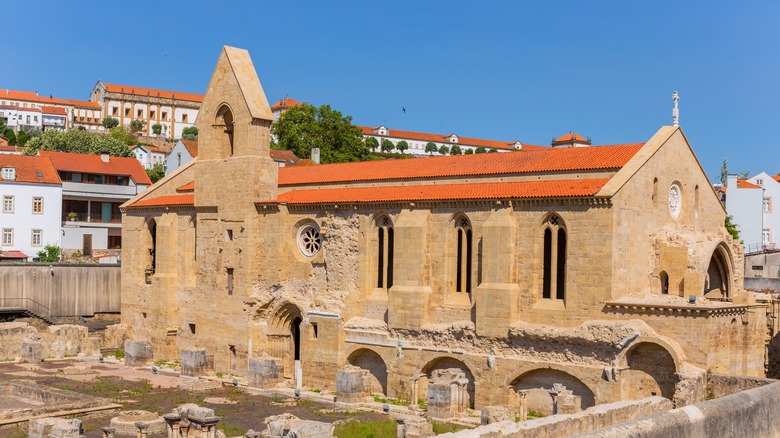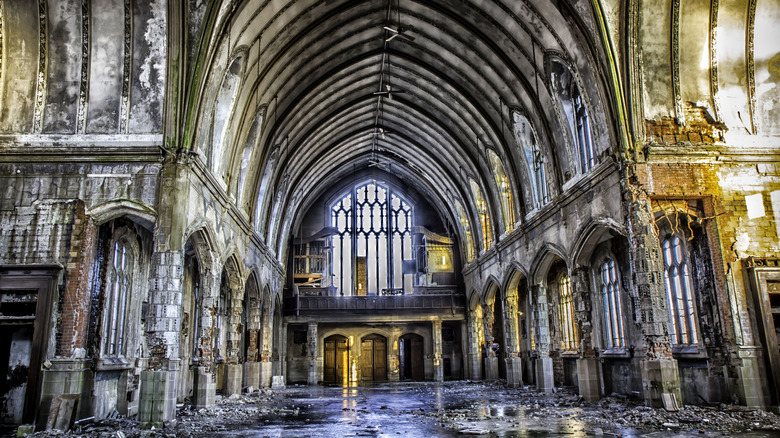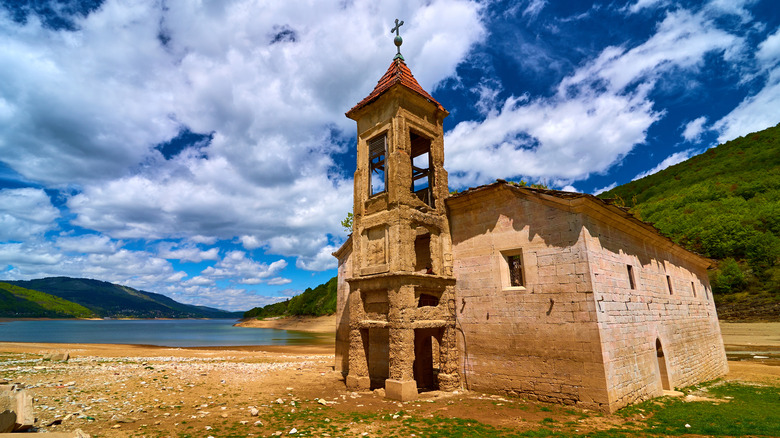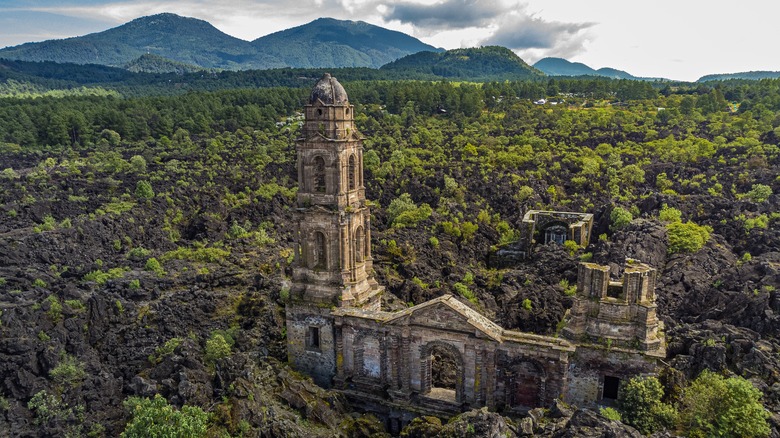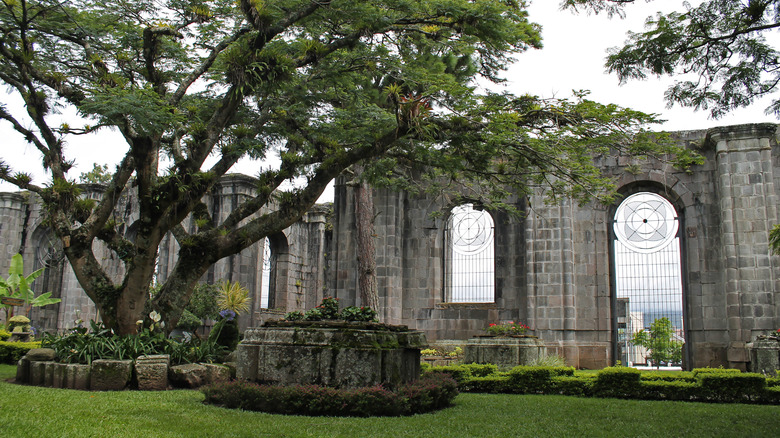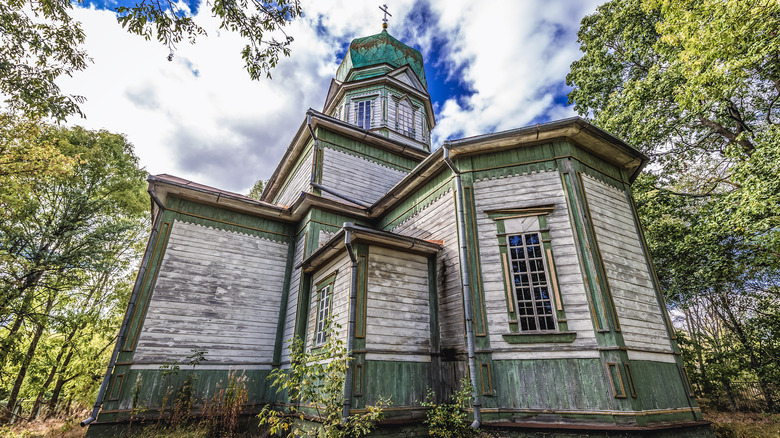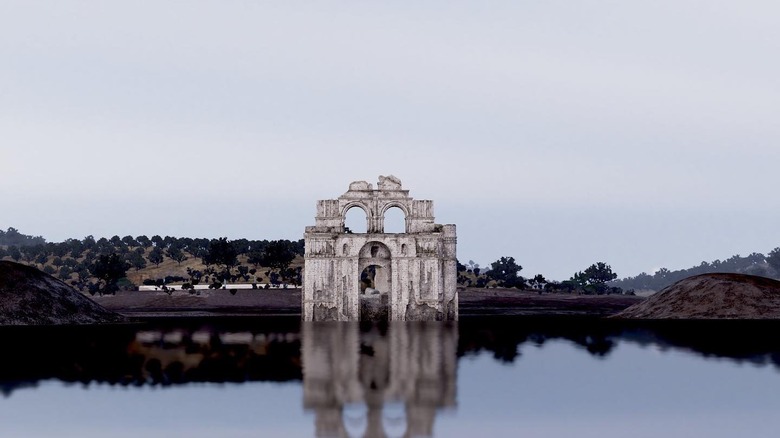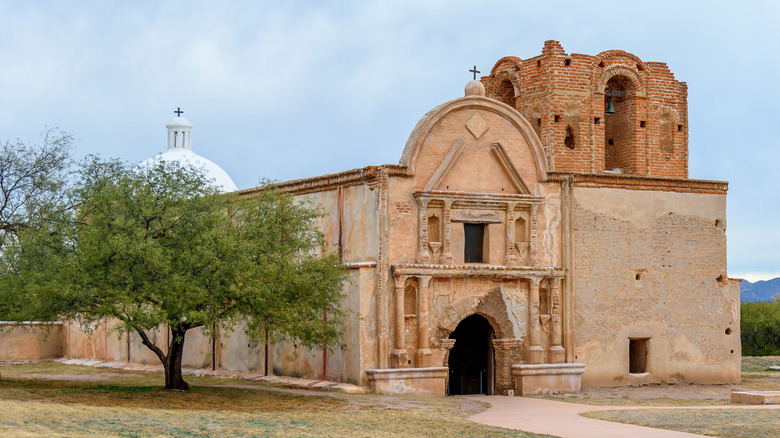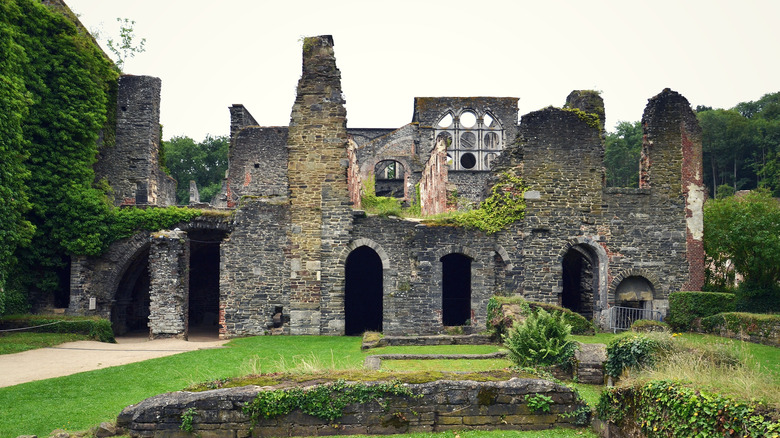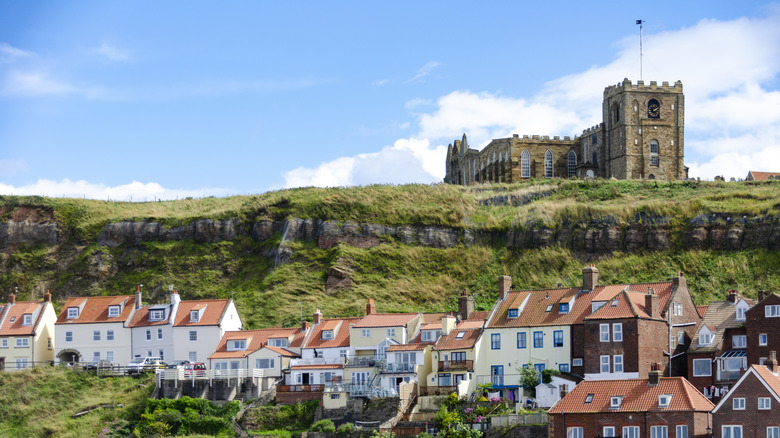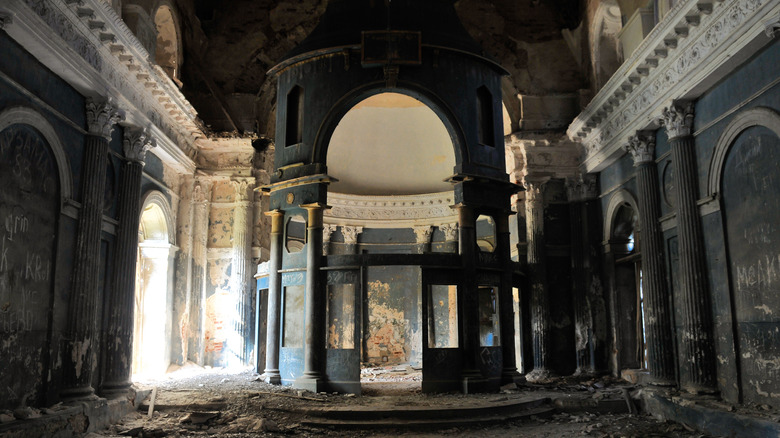15 Beautiful Abandoned Churches Around The World
Throughout history, churches — whether Catholic, Buddhist, or somewhere in between — have been monumental community gathering places and respites. But despite their holy demeanors, churches are, in some ways, like any other buildings, and they can become victims to artificial or natural elements and fall to the wayside of the people who once relished their grand architecture, stained glass, ringing bell towers, and peaceful presence.
Unfortunately, that's precisely what happened to these churches. Everything from volcanic eruptions to civil unrest to big bills sent congregants out of these buildings, leaving the structures to crumble and become ruins and relics. However, even as ruins and without worshippers, these churches are still beautiful in their own ways and remain trapped in time to when they were neighborhood staples flooded with people. While you can visit some of these by paying an admission fee and taking a guided tour, to reach others, you'll have to trek through forgotten towns with your camera and sense of adventure in tow.
Aulne Abbey, Wallonia, Belgium
Aulne Abbey has been situated in the Valley of Peace, an hour-long drive from Brussels, since A.D. 657. It got its start as a Benedictine monastery after it was founded by later-canonized Abbot Landelin of Crespin. Nearly 500 years later, it became a Cistercian abbey, and it remained so for hundreds of years until French troops destroyed the elegance that the abbey was known for in 1794. However, it wasn't officially abandoned by the monks who called it home until 1859, when it began its tenure as a hospice.
While monks lived at Aulne Abbey, they made their own beer for the 1,000 residents. Today, visitors can taste the monks' work as the beer is still produced in the abbey's former stables. This is no ordinary beer, as it was never served to those not part of the abbey before 1950. Those who want a cold brew and also want to learn some history can do so by purchasing a €5 ticket, as the abbey is now a historic site owned by the Wallonia region of Belgium.
Church of the Holy Redeemer, Ani, Türkiye
The Church of the Holy Redeemer, built sometime between the 10th and 11th centuries, is just one of a few of its kind. That's because the building with ecclesiastical architecture is one of the final surviving structures in Ani, the now-ruined former Armenian kingdom on the eastern edge of modern Türkiye. The remains of the church are located about 40 minutes from Kars and cost about $6 to visit. The church is known for its one-of-a-kind look and colors, and it features a colossal dome. Historical texts suggest that the church was initially built to hold pieces of the true cross, on which Jesus Christ was thought to be crucified. However, it might not be here at all if it wasn't for the World Monuments Fund, which deemed it in danger in 1996 before conservation efforts began in 2009.
It was desperately needed for the historic structure, which featured an enormous crack (likely due to an earthquake) and was also subject to a lightning strike in 1930, leading to half the structure's demise. Today, it's just a fragment of its age-old self, although vandals, history buffs, and religious followers continue to see it in person.
City Methodist Church, Gary, Indiana
If the City Methodist Church looks familiar, you're not imagining things. That's because this Gothic Revival church adorned with every over-the-top detail a church can muster has featured in blockbuster movies such as "A Nightmare on Elm Street" and "Transformers 3." With architectural features like molded arches, colossal pillars, and stained glass, you can't blame directors for choosing these century-old ruins for their movies, showcasing one of the most chilling abandoned places in America.
The church was built for $1 million — which would be more than $7 million today – after a $500,000 donation from U.S. Steel, which was based in Gary at the time. Thousands of congregants gathered here for years, but as the steel industry left, so did Gary residents, and by 1975, the church shut its doors. Throughout the years, efforts have been made to redevelop the ruins as a site for weddings and other events, but so far, none of the grants that organizers have applied for have come to fruition. In the meantime, it remains a pile of decrepit debris in the big city and a destination for curious explorers who don't mind the risky nature of the site's instability.
Lincluden Collegiate Church, Dumfries, Scotland
No one is entirely sure when the Lincluden Collegiate Church was built or who constructed it, but prevailing wisdom suggests it dates to around A.D. 1400 and was probably created by John Morrow, one of the best masons in the country. Supposedly, Archibald the Grim, Lord of Galloway, demanded the building of the church so that a provost, eight priests, and two dozen beadsmen could pray for Archibald and his family. However, it was abandoned by the late 1600s after a new owner bought the property.
Today, the church continues to be admired for its Gothic architecture and can be visited for free at any time. While here, check out the still-standing choir and part of the nave inside the church. However, don't expect much fanfare when you arrive at Lincluden Collegiate Church, about an hour and a half from Glasgow. Even though it's home to Archibald's wife Princess Margaret's circa-1450 tomb and its detailed carvings can still be seen in all their glory, the church is hidden in a neighborhood of modern homes, and no signage points it out.
Monastery of Santa Clara-a-Velha, Coimbra, Portugal
The Monastery of Santa Clara is one of two monasteries with similar names in the area, which is about a two-hour drive north of Lisbon, Portugal, an expert-approved top travel destination in 2024. This monastery, which dates back to 1283, is the original, hence the "a-velha" (which means "the old" in Portuguese). A new one was built after this monastery, which is located on the flood plain of the Mondego River, continued to be destroyed by floods until it was finally abandoned by the nuns who once lived here.
After hundreds of years spent unoccupied and falling victim to the elements, the Monastery of Santa Clara-a-Velha was restored, and since 2009, it has been open to the public as a living museum. Within the ruins of this National Monument, visitors can see the displayed relics found here, watch a short movie about the monastery's history, and see various exhibits for €4 per person. It usually takes people about an hour to explore the site, which still features original tiles and rose windows.
St. Agnes Church, Detroit, Michigan
In its heyday, St. Agnes Church was home to three priests, nearly two dozen nuns, and around 200 girls who studied at the attached Catholic school. About 1,600 families worshipped inside the Gothic-style building built in 1924, and even Mother Teresa visited and brought three nuns to serve the church and the bustling community. But, after July 23, 1967, nothing would ever be the same for the grand church.
After more than 80 Black people were arrested by police officers at an illegal club hosting a welcome home party for two Vietnam War veterans, the Detroit Riot of 1967 broke out, lasting five days. Although St. Agnes Church wasn't one of the 1,000 buildings to be burned, many Catholic families fled the area, and soon, only 162 families remained congregants at the church. It was quickly abandoned, and any features of value, like the metal pipes from its organ and décor, were stolen. Today, it remains abandoned, with "no trespassing" signs surrounding the building.
Church of St. Nicholas, Mavrovo, North Macedonia
The Church of St. Nicholas was constructed in 1857 in the Bistra Mountains in Mavroro, which is about 90 minutes from Skopje, close to the border between North Macedonia and Albania. It was made with high-quality granite and marble by local workers, and it seems as though those materials and skills have paid off. Even though the church was sunk into the artificial Mavrovo Lake along with several other buildings in 1947, when the Mavrovo River was dammed, it remains the only building still standing. Despite its submersion at that time, it can now be visited, depending on the water level of the lake.
If you visit, it can seem like a Mass took place only yesterday. Even though the church no longer has a roof, votive candle stands are still sitting by the altar, and an image of St. Nicholas overlooks where the congregation would sit. Even the bell tower still stands with a peaked red roof topped with a cross.
Viejo San Juan Parangaricutiro, Angahuan, Mexico
When the Parícutin volcano formed and erupted in 1943 — making it the youngest volcano on the planet — residents fled the town, leaving Viejo San Juan Parangaricutiro behind to build the Nuevo San Juan Paragaricutiro in their new development and praise the fact that no one was hurt in the eruption. Despite nearly a decade of eruptions and flowing molten hot lava, the church still stands today, with its tower and altar still unscathed by the rock, although the wall around the church and the cemetery has been destroyed.
It's the only structure in the former bustling village that remains, as the area is buried in lava. Since the volcano is now dormant, visitors can hike over the rock to reach the church and even go inside to light candles or say prayers. However, it's not easy to reach it. Tourists can hire a guide to take them there or find it by first heading to the Angahuan bus stop before hiking for about an hour. Once you reach the Tourist Center, follow the path that leads to Viejo San Juan Parangaricutiro. Behind the church in what some people call "Mexican Pompeii," church visitors will still see Parícutin looming in the background during their visit.
Santiago Apóstol Parish, Cartago, Costa Rica
Is the Santiago Apóstol Parish cursed? It depends on how many times you think lightning can strike. The first church to be built at the site of Santiago Apóstol Parish came to be in the mid-1500s, but less than a century later, an earthquake leveled it. A similar fate befell Santiago Apóstol Parish, dating back to 1662 when three separate earthquakes brought it to its knees. Each time, parishioners brought it back to life until the final quake struck in 1841, and the church then remained in its sorry state until 1910.
At that point, locals decided to give the Santiago Apóstol Parish another chance. They began rebuilding it again until their efforts were thwarted for the fifth time when the Santa Monica earthquake struck in 1910, now known to have occurred due to the Aguacaliente Fault. Some people believed the continuous earthquakes were due to a curse, and they decided to stop attempting to rebuild the church. Besides the church, the earthquake also destroyed most of the town of Cartago. Today, the ruins of the Santiago Apóstol Parish can still be seen and are on the site of the Ruins of Cartago, which are just about an hour outside of San Jose.
St. Michael's Russian Orthodox Church, Krasne, Ukraine
Chernobyl Story ToursWhile most churches on this list were abandoned due to natural disasters, St. Michael's Russian Orthodox Church had to be left by its parishioners due to a catastrophe of the human error variety. The church sits just 5 miles from the Chernobyl Nuclear Power Plant, where a 1986 explosion forced people living within 1,600 square miles of the plant to leave their homes and communities, making it one of the most terrifying places on Earth. Within this area was St. Michael's Russian Orthodox Church, which had been a part of the neighborhood since 1800. Despite the structure's old age, it's in fair shape, perhaps due to years of unuse.
Although faded, the blue, white, and green paint still covers the building, and copper turrets still meet the sky. A book still sits inside the church where the few-and-far-between visitors can write their prayers for the Russian priest, who still oversees the church. In theory, though, those visitors don't have much to fear anymore. Strangely enough, the church's radiation levels are far below that of the rest of the zone, which some attribute to "God's will."
Temple of Santiago, Chiapas, Mexico
The Temple of Santiago, also known as the Temple of Quechula, was constructed in 1564 by Dominican monks at the behest of a famous Spanish missionary. It was expected to be a major center of worship around which the budding community could grow, but that never came to fruition, and the church likely never even had a dedicated priest. By 1773, the church was even quieter as plagues ravaged the community. It was soon abandoned and all but forgotten until the 1960s, when it was sunk 100 feet underwater with the creation of a reservoir.
These days, visitors can get a view of the church depending on the water level. Both in 2002 and 2015, the water level sunk so much that for the first time in centuries, people could walk within the church walls. Boat tours are also sometimes offered so visitors can see the half-sunken church, emerging like a grand piece of Atlantis in Mexico. It's always a jovial time in the area when the church erupts from the waters, and people celebrate with processions around the structure and exploring its ruins.
Mission San José de Tumacácori, Rio Rico, Arizona
When the Franciscans got to work in 1800 constructing Mission San José de Tumacácori, which is about 45 minutes south of Tucson, they hoped to create a showstopping place of worship that was as beautiful as Mission San Xavier del Bac, located just 45 minutes away. Unfortunately, their dreams never came to fruition. Despite the project's team being led by an expert mason and decades of work, financial problems plagued the building, as did numerous raids carried out by Apache tribes. By 1848, the Franciscans abandoned their once-grand hopes for the church, but luckily, it was recognized as a National Monument 50 years later, creating the foundation for the structure to be seen for years to come.
Today, tourists can do just that, as the Mission San José de Tumacácori is one of three churches within the Tumacácori National Historical Park. People can visit the park for $10 per person and also, depending on availability, get a guided tour of the church and see its 14-foot plaster walls dotted with red brick and domeless bell tower up close.
Villers Abbey, Villers-la-Ville, Belgium
Located 32 miles south of Brussels, Villers Abbey may have been abandoned multiple times throughout its near millennia of history, but it's always come back with a vengeance. Today, not only is it a piece of living history that draws more than 100,000 people per year, but it's also an entertainment epicenter with its own brewery and winery, as well as countless gardens and spaces for events like concerts, theater productions, and exhibits. It all began in 1146 when a few monks built the Romanesque-style abbey. It grew and prospered, with some ups and downs, until 1786, when the monks were forced to flee the abbey due to the French Revolution. Soon, it was nothing but a ruin.
However, Villers Abbey's future turned around in 1854 when tourists began to visit. About a half-century later, Belgium decided to restore the once-grand building, and in 1972, it was named a historic site. But Belgium didn't stop there. In later years, it continued to bring life to the church by establishing several colorful onsite gardens for tourists to explore, like the Medicinal Herb Garden, Abbot's Garden, and Monks' Garden. Plus, as restoration work continued, even more hidden gems of the abbey were opened to visitors, such as Abbot's Palace's basement and the Montaigu staircase. Today, the abbey is open to visitors between 10 a.m. and 6 p.m. every day (it closes at 5 p.m. between November and April). Entry costs €10 per person.
Whitby Abbey, Whitby, England
Perched upon cliffs overlooking the North Sea about an hour north of York since A.D. 657, Whitby Abbey is one of the oldest abandoned churches on this list, as well as the most well-known, even if its origins are often misunderstood. Although Whitby Abbey is in England, with its Gothic architecture and penchant for attracting bats, it was the inspiration for Bram Stoker's "Dracula" after the author visited in 1890. However, Whitby Abbey has its own place in history without the iconic novel.
Whitby Abbey was established as a monastery before it became the instrumental site where the date of Easter was decided in 664. But in the ninth century — no one is exactly sure when or why — both the surrounding town and the abbey were abandoned. Later, in 1078, the church again found new meaning as a Benedictine monastery when rebuilt with Gothic building traditions. As centuries passed and the grand structure fell into disrepair, it became a popular spot for people looking for sand and sea in Whitby. That was until 1993 when efforts were finally made to preserve what was left of the building and educate others on its significance in Whitby, one of the most scenic beach towns along the U.K.'s coast. Now, tourists can visit nearly every day from 10 a.m. to 5 p.m., and online advance entry tickets cost £10 for adults and £5.90 for children.
The Church of Our Lady of Kazan, Yaropolets, Russia
It's hard to believe that the Church of Our Lady of Kazan, which now has foliage growing from the roof, fallen Corinthian-style columns, and a fence surrounding the defunct property with no formal way for tourists to visit, was once on an estate so beautiful that Catherine II said she would live there if it weren't 80 miles from Moscow. But today, the circa-1770 church on the estate owned by Count Zakhar Chernyshev is nothing but a shell of its former self and an unfinished one at that.
Chernyshev, thought to have designed the church himself due to its unique look, died in 1784 before the building could be finished. Later, an architect hired to complete the church died, and then it was rattled by fire. Finally, it became a working parish, but only until 1966, when the final head of the monastery also died. Efforts began in 2016 to revitalize the building, but as funding dried up, so did the work, and today, it remains dilapidated.
